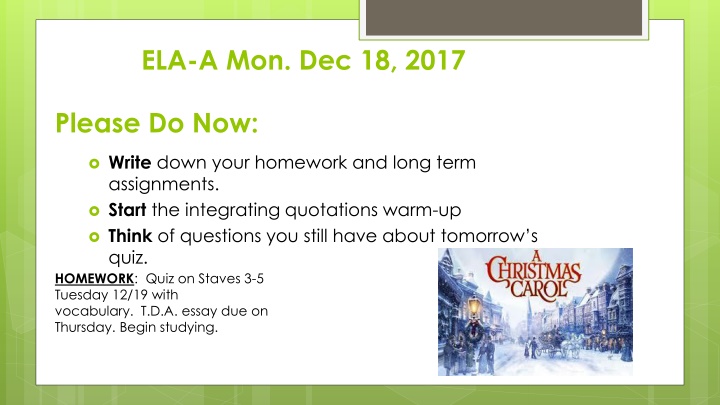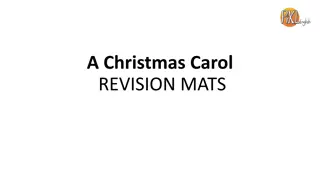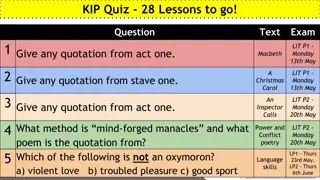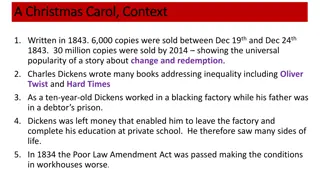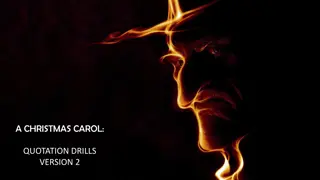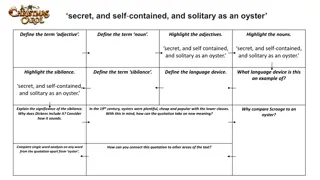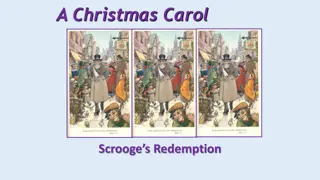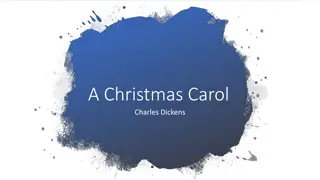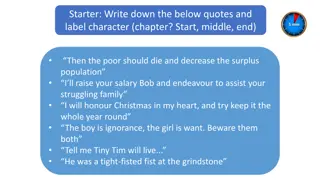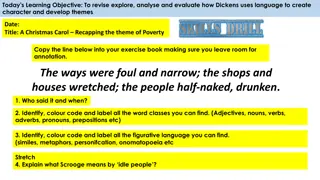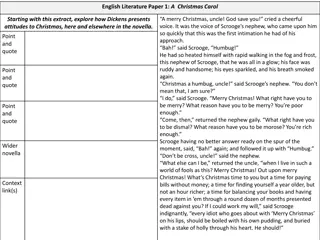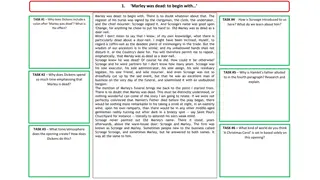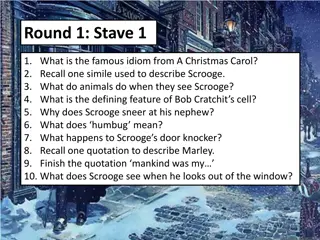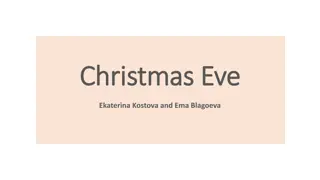Analyzing Character Change in "A Christmas Carol
In the classroom activities for December 18, 2017, students were assigned homework including a quiz on Staves 3-5 of "A Christmas Carol," with a focus on vocabulary. The students also had a T.D.A. essay due on Thursday, related to analyzing the character change of Scrooge and integrating quotations. The daily lesson involved discussing the impact of spirits on Scrooge's transformation in the novel, identifying strong text evidence, and crafting a claim statement based on common themes. The learning objective was to analyze the influencing spirit in Scrooge's development and practice integrating direct citations. The timeline for the week included work on the essay, a quiz, and finalizing printed essays for submission.
Uploaded on Sep 29, 2024 | 1 Views
Download Presentation

Please find below an Image/Link to download the presentation.
The content on the website is provided AS IS for your information and personal use only. It may not be sold, licensed, or shared on other websites without obtaining consent from the author.If you encounter any issues during the download, it is possible that the publisher has removed the file from their server.
You are allowed to download the files provided on this website for personal or commercial use, subject to the condition that they are used lawfully. All files are the property of their respective owners.
The content on the website is provided AS IS for your information and personal use only. It may not be sold, licensed, or shared on other websites without obtaining consent from the author.
E N D
Presentation Transcript
ELA-A Mon. Dec 18, 2017 Please Do Now: Write down your homework and long term assignments. Start the integrating quotations warm-up Think of questions you still have about tomorrow s quiz. HOMEWORK: Quiz on Staves 3-5 Tuesday 12/19 with vocabulary. T.D.A. essay due on Thursday. Begin studying.
Todays Learning Target: I can analyze which spirit impacted the character change of Scrooge from A Christmas Carol and choose strong, supportive text evidence to back up my opinion. I can properly integrate direct citations in my writing.
Timeline Monday: Time in class to continue to work on essay (no computers) Tuesday: Quiz (time in class after quiz to work on essay) Wednesday: Time in the library to continue typing. Thursday: PRINTED essays with rubrics are due at the beginning of class.
INTRODUCTIONS-- There are few characters more associated with Christmas than Ebenezer Scrooge... #1 Hook What would it take to completely change the personality of a man? #2 Title, Author, Background Charles Dickens s A Christmas Carol is a beloved classic that tells the tale of Ebenezer Scrooge s transformation. The main character in Charles Dickens novel A Christmas Carol is Ebenezer Scrooge, who lives in London during the 1800 s. The problem he faces is that if he doesn't change his personality and become a nicer man, then he will become a tortured ghost wrapped with chains after he dies . During the course of the story, he s visited by three ghosts who persuade him to become a better man by showing him his past, present, and future.
INTRODUCTIONS... THE CLAIM STATEMENT Think about the three reasons you selected for why the spirit you chose influenced Scrooge the most. What do they all have in common? Turn this common theme into your claim statement. Scrooge is visited by three spirits of Christmas, but the spirit who impacts Scrooge's transformation the most was the Spirit of Christmas Past. This spirit reminds Scrooge of the people who loved him and the man who he had hoped to become. The spirit leaves Scrooge filled with sadness, regret, anger and, most importantly, the desire to change. You do NOT need to have a three-prong claim statement.
COMPLETE INTRODUCTIONS & CONCLUSIONS Introductions and Conclusions mirror each other. INTRODUCTIONS CONCLUSIONS Hook/Grabber Background information Claim Statement Claim Statement Summary of Main Points Take-Away/Concluding Sentence
Main Points Tell the reader how Scrooge s change is possible. Why was he able to change?
The Take-Away or Ziiing! This is the answer to, So what?! Why should your reader care? You want to leave them thinking
Introductions and Conclusions What would it take to change the personality of a man? To get him to open his shut up heart to the potential of love and joy after years of misery? Charles Dickens takes on such a challenge with his main character, Ebenezer Scrooge, in his timeless novel, A Christmas Carol. Set in Victorian London, A Christmas Carol tells the tale of the mean Mr. Scrooge s transformation on Christmas Eve after being visited by three spirits sent to him by his dead business partner, Jacob Marley. Jacob warns Scrooge that if Scrooge doesn t listen to the message of the spirits, he will suffer greatly in the afterlife. Although all of the spirits assist in changing Scrooge from miser to Mr. Christmas, the spirit who influences this change the most is the Spirit of Christmas Past. Through the scenes this spirit shows Scrooge, Scrooge realizes that he did not grow into the man who he had desired to become in his youth. The spirit reminds Scrooge of the people who had once loved him and leaves Scrooge feeling not only regretful for his past choices, but also ready to change. Although the Spirits of Christmas work together to create a lasting change in Ebenezer Scrooge, the Spirit who influences the change the most was the Spirit of Christmas Past. By reminding Scrooge of his beloved sister and her only son, Fred, Scrooge realizes that family is the key to happiness. He understands that he can provide happiness too in the lives of others when he is reminded by the spirit how he wanted to be like Fezziwig to his future employees. Finally, he feels the deep pain of regret for not letting love into his life and losing Belle forever. He pledges to never make the same mistakes again and wakes up on Christmas morning a changed man, ready to face the world with his new attitude. May we all be reminded of the lessons taught to us through the three spirits in Charles Dickens s A Christmas Carol and remember the miracles that can occur in our lives, no matter how old we are.
INTEGRATING QUOTATIONS INTO YOUR WRITING LITERARY ANALYSIS
Scrooge not only observes businessmen laughing over his death but also witnesses vagabonds profiting from his passing. He and the Spirit travel to a dismal part of town where thieves have stolen his possessions and are now selling his belongings for money. As they laugh and joke about Scrooge s belongings, Scrooge realizes, this unhappy man this stripped-bare corpse could very well be my own (Horovitz 40). He has finally realized that the belongings being bartered for are his own; he is filled with fear and is learning his lesson.
METHODS TO INTRODUCE QUOTATIONS 1. Use an explanatory phrase 2. Slice and dice the quote to make the author s words fit perfectly with yours 3. Use a colon
USE AN INTRODUCTORY OR EXPLANATORY PHRASE Scrooge refuses to donate to the charity men exclaiming, I wish to be left alone! (Horovitz 8). .
PUNCTUATING INTRODUCTORY OR EXPLANATORY PHRASES: Use a comma to separate your own words from the quotation when your introductory or explanatory phrase ends with a verb such as "says," "thinks," "believes," exclaims, "recalls," "questions," and "asks."
PUNCTUATING INTRODUCTORY OR EXPLANATORY PHRASES: If the quote is a statement, place period after page number in parentheses: Scrooge explains to the charity men, Since you ask me what I wish, gentlemen, that is my answer (Horovitz 8).
PUNCTUATING INTRODUCTORY OR EXPLANATORY PHRASES: HOWEVER, if the quote itself has an exclamation or question mark, it stays inside the quote and a period comes at the end. Scrooge refuses to donate to the charity men exclaiming, I wish to be left alone! (Horovitz 8).
2. SLICE AND DICE I present him to you: Ebenezer Scrooge England s most tight-fisted hand at the grindstone, Scrooge! A squeezing, wrenching, grasping, scraping, clutching, covetous old sinner! Secret and self-contained and solitary as an oyster! Marley introduces Scrooge as a covetous, old sinner (Horovitz 3).
SLICE AND DICE PUNCTUATION No comma is needed before the quote because the words melt in with your sentence. Period is outside the page #.
INTRODUCE THE QUOTATION WITH A COMPLETE SENTENCE AND A COLON. Marley introduces the reader to Scrooge: England s most tight-fisted hand at the grindstone, Scrooge! (Horovitz 3).
COLON EXAMPLE 2 After your complete sentence introduction, place a colon before the quote. This prevents the quote from looking like it was randomly dropped in (very bad). Scrooge treats his clerk very badly: Let me hear another sound from you and you ll keep your Christmas by losing your situation (Horovitz 9).
TRANSITIONS Transitions ALWAYS start a new paragraph. They are NEVER at the end of a paragraph. Scrooge not only observes businessmen laughing over his death but also witnesses distasteful characters profiting from his passing. He and the Spirit travel to a dismal part of town where thieves have stolen his possessions and are now selling his belongings for money. As they laugh and joke about Scrooge s belongings, Scrooge realizes, this unhappy man this stripped-bare corpse could very well be my own (Horovitz 40). He has finally realized that the belongings being bartered for are his own; he is filled with fear and is learning his lesson. The Ghost of Christmas Yet to Come shows Scrooge that no one is mourning his passing; in fact, Londoners are laughing about it!. Upon visiting the future streets of London, Scrooge and the Spirit come across three businessmen discussing Scrooge s funeral. One sarcastically comments that he was probably Scrooge s dearest friend, for when they pass on the streets, Scrooge said hello. Another complains about the funeral and says he ll only go if lunch is provided (Horovitz 37). Though Scrooge is confused and thinks they must be talking about the death of Jacob Marley, he is able later to put the pieces together. He states, My life holds parallel! (Horovitz 40). Ghost of Christmas Yet to Come puts the fear inside of him that people will be joking about his death; this fear is a frightening motivator to alter his ways. The next place the ghost takes Scrooge is to a pawnshop.
Scrooge not only observes businessmen laughing over his death but also witnesses vagabonds profiting from his passing: This unhappy man this stripped-bare corpse could very well be my own (Horovitz 40). He has finally realized that the belongings being bartered for are his own; he is filled with fear and is learning his lesson.
